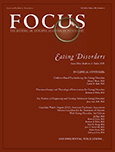In recent years, clinicians and researchers have realized that a significant number of individuals with eating disorders did not fit into the DSM-IV categories of anorexia nervosa and bulimia nervosa. By default, many received a diagnosis of “eating disorder not otherwise specified.” Studies have suggested that a significant portion of individuals in that “not otherwise specified” category may actually have binge eating disorder.
Binge Eating Disorder
Binge eating disorder was approved for inclusion in DSM-5 as its own category of eating disorder. In DSM-IV, binge-eating disorder was not recognized as a disorder but rather described in Appendix B: Criteria Sets and Axes Provided for Further Study and was diagnosable using only the catch-all category of “eating disorder not otherwise specified.”
Binge eating disorder is defined as recurring episodes of eating significantly more food in a short period of time than most people would eat under similar circumstances, with episodes marked by feelings of lack of control. Someone with binge eating disorder may eat too quickly, even when he or she is not hungry. The person may have feelings of guilt, embarrassment, or disgust and may binge eat alone to hide the behavior. This disorder is associated with marked distress and occurs, on average, at least once a week over 3 months.
This change is intended to increase awareness of the substantial differences between binge eating disorder and the common phenomenon of overeating. While overeating is a challenge for many Americans, recurrent binge eating is much less common, far more severe, and is associated with significant physical and psychological problems.
Anorexia Nervosa
Anorexia nervosa, which primarily affects adolescent girls and young women, is characterized by a distorted body image and excessive dieting that leads to severe weight loss with a pathological fear of becoming fat. The criteria have several minor but important changes:
• Criterion A focuses on behaviors, like restricting calorie intake, and no longer includes the word “refusal” in terms of weight maintenance since that implies intention on the part of the patient and can be difficult to assess. The DSM-IV Criterion D requiring amenorrhea, or the absence of at least three menstrual cycles, is deleted. This criterion cannot be applied to males, premenarchal females, females taking oral contraceptives, and postmenopausal females. In some cases, individuals exhibit all other symptoms and signs of anorexia nervosa but still report some menstrual activity.
Bulimia Nervosa
Bulimia nervosa is characterized by frequent episodes of binge eating followed by inappropriate behaviors such as self-induced vomiting to avoid weight gain. DSM-5 criteria reduce the frequency of binge eating and compensatory behaviors that people with bulimia nervosa must exhibit, to once a week from twice weekly as specified in DSM-IV.
Overall Changes
The Eating Disorders Work Group intended for the changes to DSM-5 to minimize use of the catch-all diagnoses of Other Specified Feeding or Eating Disorder and Unspecified Feeding or Eating Disorder. A primary goal is for more people experiencing eating disorders to have a diagnosis that accurately describes their symptoms and behaviors. Determining an accurate diagnosis is a first step for clinicians and patients in defining a treatment plan.

